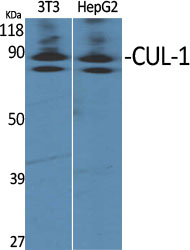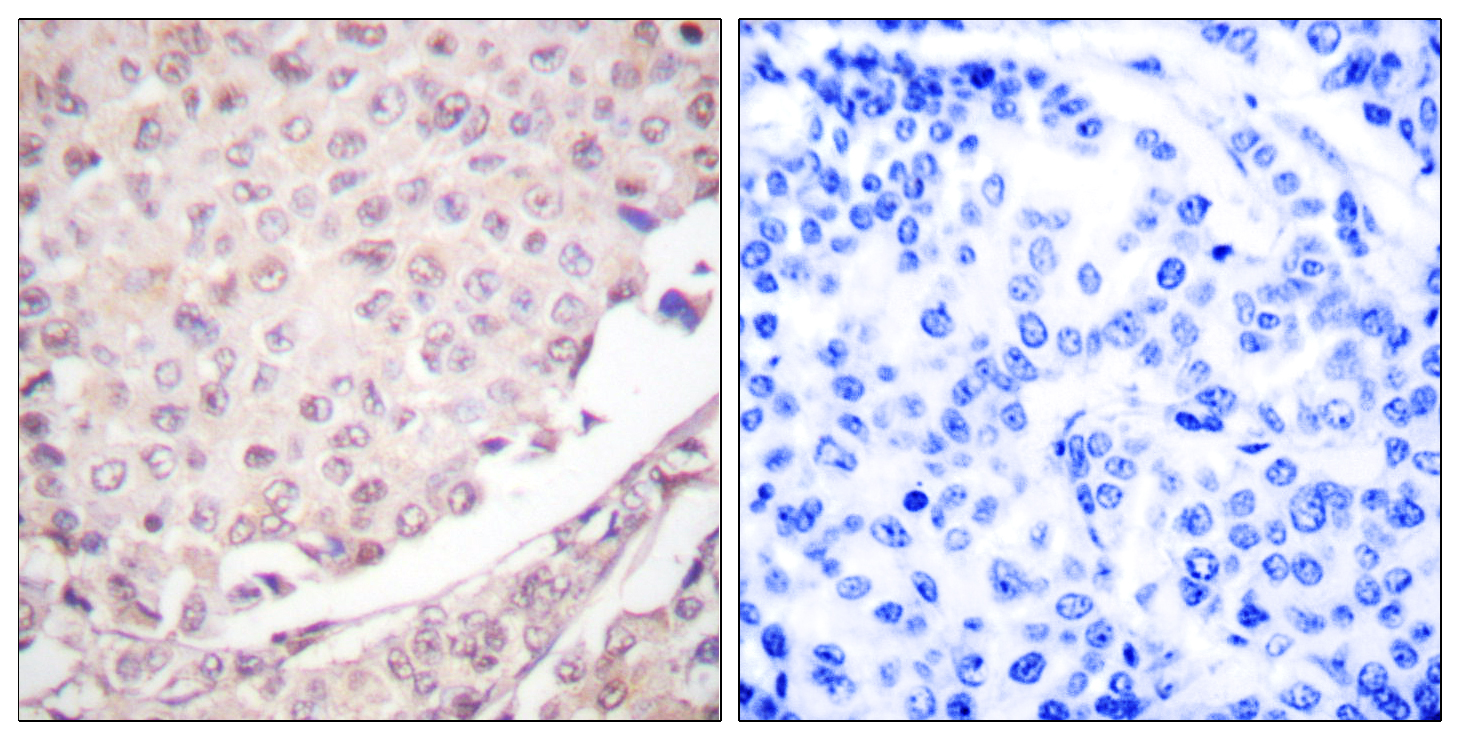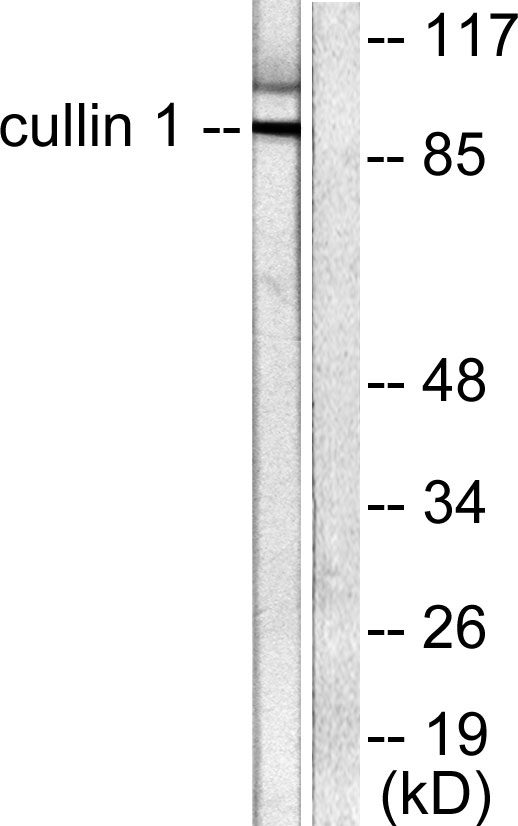CUL-1 Polyclonal Antibody
- Catalog No.:YT1157
- Applications:WB;IHC;IF;ELISA
- Reactivity:Human;Mouse;Rat
- Target:
- CUL-1
- Fields:
- >>Cell cycle;>>Oocyte meiosis;>>Ubiquitin mediated proteolysis;>>Protein processing in endoplasmic reticulum;>>Wnt signaling pathway;>>Hedgehog signaling pathway;>>TGF-beta signaling pathway;>>Circadian rhythm;>>Shigellosis;>>Human immunodeficiency virus 1 infection;>>Pathways in cancer
- Gene Name:
- CUL1
- Protein Name:
- Cullin-1
- Human Gene Id:
- 8454
- Human Swiss Prot No:
- Q13616
- Mouse Gene Id:
- 26965
- Mouse Swiss Prot No:
- Q9WTX6
- Immunogen:
- The antiserum was produced against synthesized peptide derived from human Cullin 1. AA range:727-776
- Specificity:
- CUL-1 Polyclonal Antibody detects endogenous levels of CUL-1 protein.
- Formulation:
- Liquid in PBS containing 50% glycerol, 0.5% BSA and 0.02% sodium azide.
- Source:
- Polyclonal, Rabbit,IgG
- Dilution:
- WB 1:500 - 1:2000. IHC 1:100 - 1:300. IF 1:200 - 1:1000. ELISA: 1:20000. Not yet tested in other applications.
- Purification:
- The antibody was affinity-purified from rabbit antiserum by affinity-chromatography using epitope-specific immunogen.
- Concentration:
- 1 mg/ml
- Storage Stability:
- -15°C to -25°C/1 year(Do not lower than -25°C)
- Other Name:
- CUL1;Cullin-1;CUL-1
- Observed Band(KD):
- 90kD
- Background:
- function:Core component of multiple cullin-RING-based SCF (SKP1-CUL1-F-box protein) E3 ubiquitin-protein ligase complexes, which mediate the ubiquitination of proteins involved in cell cycle progression, signal transduction and transcription. In the SCF complex, serves as a rigid scaffold that organizes the SKP1-F-box protein and RBX1 subunits. May contribute to catalysis through positioning of the substrate and the ubiquitin-conjugating enzyme. The E3 ubiquitin-protein ligase activity of the complex is dependent on the neddylation of the cullin subunit and is inhibited by the association of the deneddylated cullin subunit with TIP120A/CAND1. The functional specificity of the SCF complex depends on the F-box protein as substrate recognition component. SCF(BTRC) and SCF(FBXW11) direct ubiquitination of CTNNB1 and participates in Wnt signaling. SCF(BTRC) and SCF(FBXW11) direct ubiquitination of phosphorylated NFKBIA. SCF(BTRC) directs ubiquitination of NFKBIB, NFKBIE, ATF4, SMAD3, SMAD4, CDC25A, FBXO5 and probably NFKB2. SCF(SKP2) directs ubiquination of phosphorylated CDKN1B/p27kip and is involved in regulation of G1/S transition. SCF(SKP2) directs ubiquination of ORC1L, CDT1, RBL2, ELF4, CDKN1A, RAG2, FOXO1A, and probably MYC and TAL1. SCF(FBXW7) directs ubiquitination of cyclin E, NOTCH1 released notch intracellular domain (NICD), and probably PSEN1. SCF(FBXW2) directs ubiquitination of GCM1. SCF(FBXO32) directs ubiquitination of MYOD1. SCF(FBXO7) directs ubiquitination of BIRC2 and DLGAP5. SCF(FBXO33) directs ubiquitination of YBX1 (By similarity). SCF(FBXO11) does not seem to direct ubiquitination of TP53. Interacts with FBXW8. Interacts with CUL7; the interaction seems to be mediated by FBXW8.,pathway:Protein modification; protein ubiquitination.,PTM:Neddylated; which enhances the ubiquitination activity of SCF. Deneddylated via its interaction with the COP9 signalosome (CSN) complex.,similarity:Belongs to the cullin family.,subunit:Component of multiple SCF (SKP1-CUL1-F-box) E3 ubiquitin-protein ligase complexes formed of CUL1, SKP1A, RBX1 and a variable F-box domain-containing protein as substrate-specific subunit. Component of the SCF(BTRC) complex containing BTRC. Component of the SCF(FBXW11) complex containing FBXW11. Component of the SCF(SKP2) complex containing SKP2, in which it interacts directly with SKP1, SKP2 and RBX1. Component of the SCF(FBXW2) complex containing FBXw2. Component of the SCF(FBXO32) complex containing FBXO32. Component of the probable SCF(FBXO7) complex containing FBXO7. Component of the SCF(FBXO11) complex containing FBXO11. Component of the SCF(FBXO25) complex containing FBXO25. Component of the SCF(FBXO33) complex containing FBXO33. Component of the probable SCF(FBXO4) complex containing FBXO4. Interacts with RNF7. Part of a complex with TIP120A/CAND1 and RBX1. The unneddylated form interacts with TIP120A/CAND1 and the interaction negatively regulates the association with SKP1 in the SCF complex. Interacts with COPS2. Can self-associate.,tissue specificity:Expressed in lung fibroblasts.,
- Function:
- function:Core component of multiple cullin-RING-based SCF (SKP1-CUL1-F-box protein) E3 ubiquitin-protein ligase complexes, which mediate the ubiquitination of proteins involved in cell cycle progression, signal transduction and transcription. In the SCF complex, serves as a rigid scaffold that organizes the SKP1-F-box protein and RBX1 subunits. May contribute to catalysis through positioning of the substrate and the ubiquitin-conjugating enzyme. The E3 ubiquitin-protein ligase activity of the complex is dependent on the neddylation of the cullin subunit and is inhibited by the association of the deneddylated cullin subunit with TIP120A/CAND1. The functional specificity of the SCF complex depends on the F-box protein as substrate recognition component. SCF(BTRC) and SCF(FBXW11) direct ubiquitination of CTNNB1 and participates in Wnt signaling. SCF(BTRC) and SCF(FBXW11) direct ubiquitinati
- Subcellular Location:
- nucleoplasm,cytosol,SCF ubiquitin ligase complex,cullin-RING ubiquitin ligase complex,Parkin-FBXW7-Cul1 ubiquitin ligase complex,
- Expression:
- Expressed in lung fibroblasts.
The Catalytically Inactive Mutation of the Ubiquitin-Conjugating Enzyme CDC34 Affects its Stability and Cell Proliferation. PROTEIN JOURNAL Protein J. 2018 Apr;37(2):132-143 WB Human HEK293T cell, HeLa cell
- June 19-2018
- WESTERN IMMUNOBLOTTING PROTOCOL
- June 19-2018
- IMMUNOHISTOCHEMISTRY-PARAFFIN PROTOCOL
- June 19-2018
- IMMUNOFLUORESCENCE PROTOCOL
- September 08-2020
- FLOW-CYTOMEYRT-PROTOCOL
- May 20-2022
- Cell-Based ELISA│解您多样本WB检测之困扰
- July 13-2018
- CELL-BASED-ELISA-PROTOCOL-FOR-ACETYL-PROTEIN
- July 13-2018
- CELL-BASED-ELISA-PROTOCOL-FOR-PHOSPHO-PROTEIN
- July 13-2018
- Antibody-FAQs
- Products Images

- Western Blot analysis of various cells using CUL-1 Polyclonal Antibody
.jpg)
- Western Blot analysis of HeLa cells using CUL-1 Polyclonal Antibody

- Immunofluorescence analysis of HeLa cells, using Cullin 1 Antibody. The picture on the right is blocked with the synthesized peptide.

- Immunohistochemistry analysis of paraffin-embedded human lung carcinoma tissue, using Cullin 1 Antibody. The picture on the right is blocked with the synthesized peptide.

- Western blot analysis of lysates from HeLa cells, using Cullin 1 Antibody. The lane on the right is blocked with the synthesized peptide.



